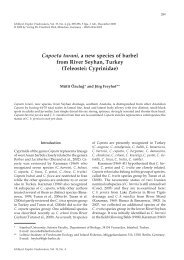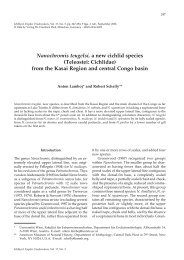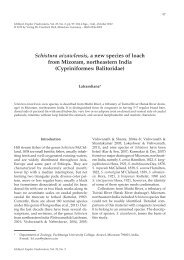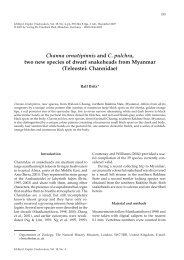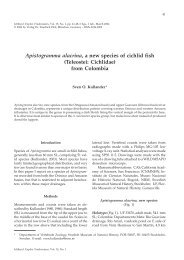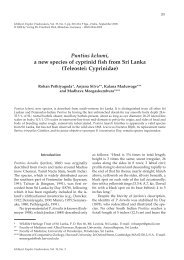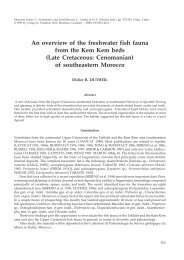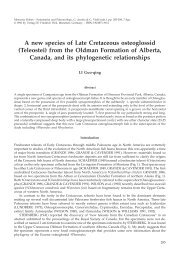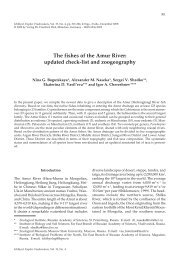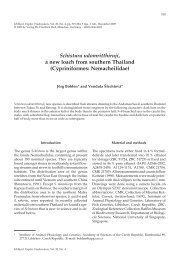The phylogenetic relationships of the â Enchodontidae - Verlag Dr ...
The phylogenetic relationships of the â Enchodontidae - Verlag Dr ...
The phylogenetic relationships of the â Enchodontidae - Verlag Dr ...
You also want an ePaper? Increase the reach of your titles
YUMPU automatically turns print PDFs into web optimized ePapers that Google loves.
Recent Advances in <strong>the</strong> Origin and Early Radiation <strong>of</strong> Vertebrates<br />
G. Arratia, M. V. H. Wilson & R. Cloutier (eds.): pp. 619-634, 8 figs., 2 tabs., 1 app.<br />
© 2004 by <strong>Verlag</strong> <strong>Dr</strong>. Friedrich Pfeil, München, Germany – ISBN 3-89937-052-X<br />
<strong>The</strong> <strong>phylogenetic</strong> <strong>relationships</strong><br />
<strong>of</strong> <strong>the</strong> †Enchodontidae<br />
(Teleostei: Aulopiformes)<br />
Christopher FIELITZ<br />
Abstract<br />
A <strong>phylogenetic</strong> hypo<strong>the</strong>sis <strong>of</strong> <strong>relationships</strong> among certain fossil aulopiform fishes and <strong>the</strong>ir relationship to extant<br />
aulopiform fishes was inferred by using morphology. A consensus <strong>of</strong> three equally parsimonious trees found that<br />
fossil aulopiform fishes consisting <strong>of</strong> †Cimolichthys, †Enchodus, †Eurypholis, †Palaeolycus, †Parenchodus, †Rharbichthys,<br />
and †Saurorhamphus are <strong>the</strong> sister group to <strong>the</strong> Alepisauridae (Alepisaurus and Omosudis). †Rharbichthys was<br />
basal to a clade consisting <strong>of</strong> †Palaeolycus + ((†Eurypholis + †Saurorhamphus) + (†Enchodus + †Parenchodus)). <strong>The</strong><br />
position <strong>of</strong> †Parenchodus suggests that it is a highly derived species <strong>of</strong> †Enchodus. <strong>The</strong> position <strong>of</strong> †E. marchesettii<br />
as <strong>the</strong> basal species suggests that <strong>the</strong> genus arose in <strong>the</strong> mid-Tethys Ocean in what is now <strong>the</strong> Middle East. <strong>The</strong><br />
clade consisting <strong>of</strong> (†E. venator + †E. shumardi) + (†E. gracilis + (†E. petrosus + (†E. gladiolus + †E. dirus))) suggests<br />
that <strong>the</strong>se species originated from North America with ancestors <strong>of</strong> †E. venator and †E. gracilis migrating to <strong>the</strong><br />
western edge <strong>of</strong> <strong>the</strong> Tethys Sea.<br />
Introduction<br />
Fossil species <strong>of</strong> <strong>the</strong> order Aulopiformes are common teleostean members <strong>of</strong> many late Cretaceous<br />
ichthy<strong>of</strong>aunas. <strong>The</strong>y make up approximately 30 % <strong>of</strong> <strong>the</strong> teleost species within <strong>the</strong> Smoky Hill member <strong>of</strong><br />
<strong>the</strong> Niobrara Chalk (RUSSELL 1988). In all likelihood <strong>the</strong>se fishes were mid-food chain predators. Specimens<br />
have been found in <strong>the</strong> digestive tract <strong>of</strong> o<strong>the</strong>r teleost species (CAVIN 1999) and <strong>the</strong>re are instances<br />
where smaller species <strong>of</strong> Cretaceous aulopiforms have been found in <strong>the</strong> digestive tracts <strong>of</strong> larger aulopiform<br />
species (L. Mauck pers. comm. 1994). <strong>The</strong> current classification (NELSON 1994) places all <strong>of</strong> <strong>the</strong> fossil<br />
aulopiforms in a single suborder, Enchodontoidei, consisting <strong>of</strong> four superfamilies: Enchodontoidea,<br />
Cimolichthyoidea, Halecoidea, and Ichthyotringoidea. <strong>The</strong> Enchodontoidea is one <strong>of</strong> <strong>the</strong> more species-rich<br />
fossil aulopiform superfamilies. Although it contains five recognized genera (†Enchodus, †Eurypholis,<br />
†Palaeolycus, †Parenchodus, and †Saurorhamphus) compared to nine <strong>of</strong> Cimolichthyoidea, †Enchodus alone<br />
contains an estimated 20 species (CHALIFA 1996). Members <strong>of</strong> <strong>the</strong> Enchodontoidea have been found<br />
worldwide (Table 1) from <strong>the</strong> Upper Cretaceous (Cenomanian to Maastrichtian) into <strong>the</strong> Lower Tertiary<br />
(GREEN 1913, GOODY 1976, CHALIFA 1996). <strong>The</strong> members <strong>of</strong> this taxon are distinguished from <strong>the</strong> o<strong>the</strong>r<br />
aulopiform taxa, both living and extinct, by a large single tooth on <strong>the</strong> dermopalatine, and in most species<br />
by <strong>the</strong> presence <strong>of</strong> an anterior tooth on <strong>the</strong> dentary that is at least twice <strong>the</strong> size <strong>of</strong> <strong>the</strong> next largest tooth<br />
on <strong>the</strong> dentary. Although extensive descriptive work has been done and <strong>the</strong>re has been much discussion<br />
<strong>of</strong> <strong>the</strong> taxonomy, little work has been little examination <strong>of</strong> <strong>the</strong>ir <strong>phylogenetic</strong> <strong>relationships</strong>.<br />
Prior to WOODWARD (1901), <strong>the</strong> genera that currently comprise <strong>the</strong> Enchodontoidea were placed in<br />
various families (AGASSIZ 1835, PICTET 1850, COPE 1872, 1874). WOODWARD (1901) placed <strong>the</strong><br />
Enchodontidae in <strong>the</strong> suborder Isospondyli and divided <strong>the</strong> family into two unnamed groups based on<br />
dermopalatine teeth. One group, which possesses a single tooth on <strong>the</strong> dermopalatine, consisted <strong>of</strong><br />
†Enchodus, †Eurypholis, and †Palaeolycus. WOODWARD (1901) considered †Saurorhamphus freyeri to be a<br />
species <strong>of</strong> †Eurypholis. <strong>The</strong> second group, which possesses a dermopalatine with many teeth, consisted <strong>of</strong><br />
619
<strong>The</strong> whole contribution can be<br />
purchased as PDF file.<br />
Availability<br />
Generally all our publications are available as PDF fi les;<br />
full publications as a general rule after <strong>the</strong> printed version<br />
is out <strong>of</strong> print. If you have questions concerning particular<br />
contributions please contact us by e-mail:<br />
pdf@pfeil-verlag.de.<br />
<strong>The</strong> PDF files are protected by copyright.<br />
<strong>The</strong> PDF fi le may be printed for personal use.<br />
<strong>The</strong> reproduction and dissemination <strong>of</strong> <strong>the</strong> content or<br />
part <strong>of</strong> it is permitted.<br />
It is not allowed to transfer <strong>the</strong> digital personal certifi cate<br />
or <strong>the</strong> password to o<strong>the</strong>r persons.<br />
Prices<br />
Books: Prices are to be found in <strong>the</strong> catalog.<br />
Articles in journals and single contributions or chapters<br />
in books:<br />
10 EURO basic price per order (including <strong>the</strong> fi rst 10<br />
pages),<br />
and<br />
0.50 EURO per page, beginning with <strong>the</strong> 11 th page.<br />
Page numbers are found in <strong>the</strong> contents <strong>of</strong> <strong>the</strong> publications.<br />
Orders<br />
Use our order form for PDF fi les or send your order informal<br />
per e-mail (pdf@pfeil-verlag.de). <strong>The</strong> only accepted<br />
payment is by credit card. While using <strong>the</strong> order<br />
form for PDF files, your data will be transmitted by secure<br />
link (ssl). You also may send <strong>the</strong> informations informally<br />
by e-mail, fax, phone or mail.<br />
Handling<br />
As soon as possible, depending on our business hours<br />
and your order, you will receive your PDF fi le toge<strong>the</strong>r<br />
with <strong>the</strong> certifi cate and password by e-mail.<br />
Larger PDF files can be downloaded from our webspace,<br />
if necessary.<br />
Your invoice will be sent out by e-mail after we charged<br />
your credit card.<br />
To open <strong>the</strong> encrypted PDF fi les you have to install your<br />
personal certifi cate after your fi rst order. All PDF fi les<br />
with <strong>the</strong> same certifi cate can be opened from that time<br />
on.<br />
Dieser Beitrag kann als<br />
PDF-Datei erworben werden.<br />
Verfügbarkeit von PDF-Dateien<br />
Prinzipiell sind von allen unseren Publikationen PDF-<br />
Dateien erhältlich. Komplette Publikationen in der Regel<br />
erst nachdem die gedruckte Version vergriffen ist. Anfragen<br />
bezüglich bestimmter Beiträge richten Sie bitte<br />
per E-Mail an pdf@pfeil-verlag.de.<br />
Die PDF-Dateien sind urheberrechtlich geschützt.<br />
Ein Ausdruck der PDF-Dateien ist nur für den persönlichen<br />
Gebrauch erlaubt.<br />
Die Vervielfältigung von Ausdrucken, erneutes Digitalisieren<br />
sowie die Weitergabe von Texten und Abbildungen<br />
sind nicht gestattet.<br />
Das persönliche Zertifikat und das Passwort dürfen nicht<br />
an <strong>Dr</strong>itte weitergegeben werden.<br />
Preise<br />
Bücher: Die Preise sind dem Katalog zu entnehmen.<br />
Zeitschriftenbeiträge und einzelne Kapitel aus Sammelbänden<br />
bzw. Büchern:<br />
10 EURO Grundbetrag pro Bestellung (einschließlich<br />
der ersten 10 Seiten),<br />
und<br />
0,50 EURO pro Seite ab der 11. Seite.<br />
Den Umfang der Beiträge entnehmen Sie bitte den Inhaltsverzeichnissen.<br />
Bestellungen<br />
Bestellungen sind mit dem PDF-Bestellformular oder<br />
formlos per E-Mail (pdf@pfeil-verlag.de) an uns zu<br />
richten. Die Bezahlung ist ausschließlich per Kreditkarte<br />
möglich. Bei Verwendung unseres Bestellformulars<br />
werden die Kreditkartendaten über eine gesicherte<br />
Verbindung (ssl) übermittelt. Sie können die Daten aber<br />
auch formlos per E-Mail, Fax, Post oder telefonisch<br />
übermitteln.<br />
Abwicklung<br />
So bald wie möglich, aber abhängig von unseren Bürozeiten<br />
und der gewünschten Bestellung, schicken wir<br />
Ihnen die PDF-Datei(en) zusammen mit Ihrem persönlichen<br />
Zertifi kat und dem zugehörigem Passwort per<br />
E-Mail. Größere Dateien bieten wir Ihnen gegebenenfalls<br />
zum Herunterladen an.<br />
Der fällige Betrag wird von Ihrer Kreditkarte abgebucht<br />
und Sie erhalten die Rechnung ebenfalls per E-Mail.<br />
Um die verschlüsselten PDF-Dateien öffnen zu können,<br />
muss bei der ersten Bestellung das passwortgeschützte<br />
persönliches Zertifi kat installiert werden, welches<br />
anschließend auf dem Rechner verbleibt. Alle mit diesem<br />
Zertifi kat verschlüsselten Dateien können anschließend<br />
auf diesem Rechner geöffnet werden.




